In this increasingly digital world, you might easily overlook a channel that offers the strongest marketing ROI.
We’re blasted with so much digital noise, and I can’t blame you for missing out on this. The best part is that direct mail marketing is so underused and unsaturated that you can use it as a new business edge, lead generator, and so much more. It will cut right through the digital noise and deliver your message to your ideal customer.
But don’t let me preach direct mail. Let’s look at the latest data.
The latest research shows that 57% of boomers, 45% of GenX, 41% of millennials, and 37% of GenZ would be disappointed if they stopped getting physical mail.
As the leading direct mail automation software, we at Postalytics spend a lot of time studying cutting-edge research and uncovering the next big thing in marketing. And we’re super happy to share our discoveries.
Key direct mail statistics – Editor’s choice
- Direct mail has a higher open rate of 80-90%, whereas email has 20-30%.
- Direct mail receives the highest ROI of 112% across all mediums, followed by SMS (102%), email (93%), paid search (88%) (3)
- Coordinating digital and direct mail increased the response rate by 63%, website visits by 68%, and leads by 53% (19)
- Americans feel the most comfortable when receiving direct mail, with 25% preferring it over any other advertising channel, including TV and radio ads (24%), digital advertising (11%), and social media ads (11%) (4)
- In 2021, an average household in the US received 361 pieces of marketing direct mail and 94 pieces of non-profit direct mail (2)
- On average, marketers spend between $100-500/per person on direct mail (6)
- Some 71% of consumers feel that direct mail is more personal than online digital communication. In fact, by adding a name to your recipient increases response rate up to 135%. (20)
- Direct mail speeds up the purchase timeframe. On average, any purchase decision takes longer than a week and over a third takes more than a month. However, with direct mail, 73% of purchase decisions take only 1+ day (21)
- Half (52%) of customers expect direct mail to be personalized. (7)
General Direct Mail Statistics
The US postal service started in the 18th century, and the first marketing mail was sent almost a century later. Since then, direct mail has been a constant part of marketers’ promotional mix. These direct mail statistics prove that direct mail still has immense value for consumers.
- In the world of social media and emails, 42.2% of Americans look forward to checking their mailbox daily. Especially half of the adults over 65 years and more are keen on checking their mailbox; even 36% of adults feel this way. (1)
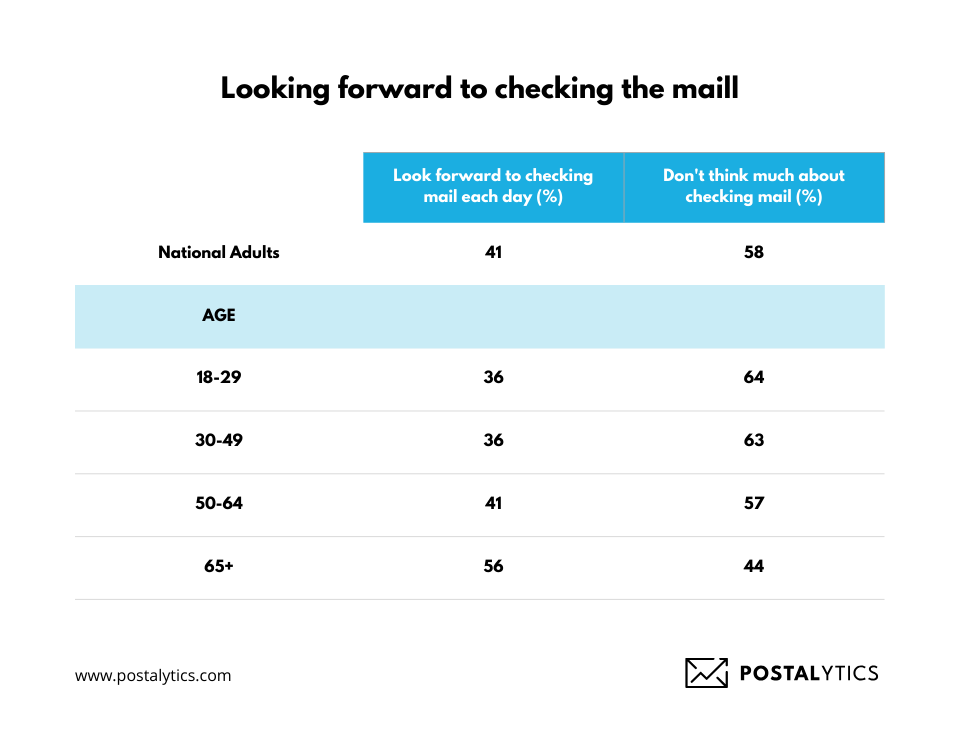
- In 2021, an average household in the US received 361 pieces of marketing direct mail and 94 pieces of non-profit direct mail. (2)
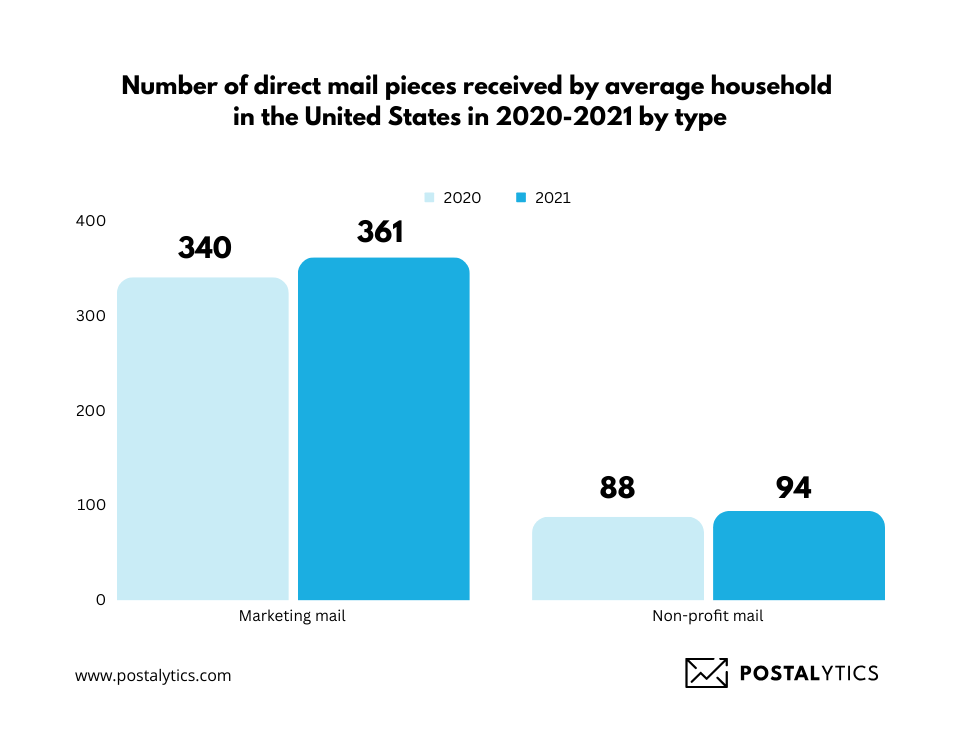
- Research by the Association of National Advertisers (ANA) says that oversized envelopes have the highest direct mail response rate, followed by 5.7% in postcards and letter-sized envelopes at 4.3%. (3)
- According to the latest projections, direct mail annual ad revenue in the United States alone will reach almost $13.2 billion, accounting for almost one-fifth of the global direct mail ad revenue estimated at nearly $77 billion. (4)
- The most common direct mail formats used by marketers in the US are-
- Newsletters & postcards- 66%
- Self-mailers-56%
- Catalog-48%
- Packages-45% (5)

- Over 91% of promo mail are read and opened. (6)
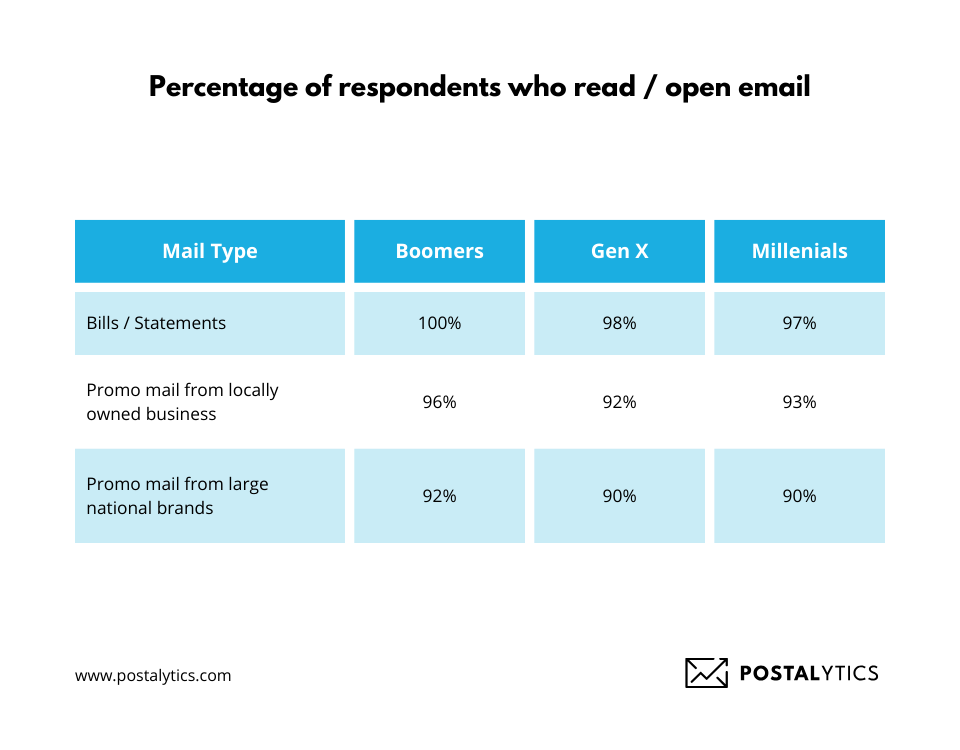
- The most important reason why marketers still prefer direct mail is that they can easily measure campaign success. The multi-touch attribution model (58%) is the most used performance measurement tool, and QR codes (38%) are the least. (6)
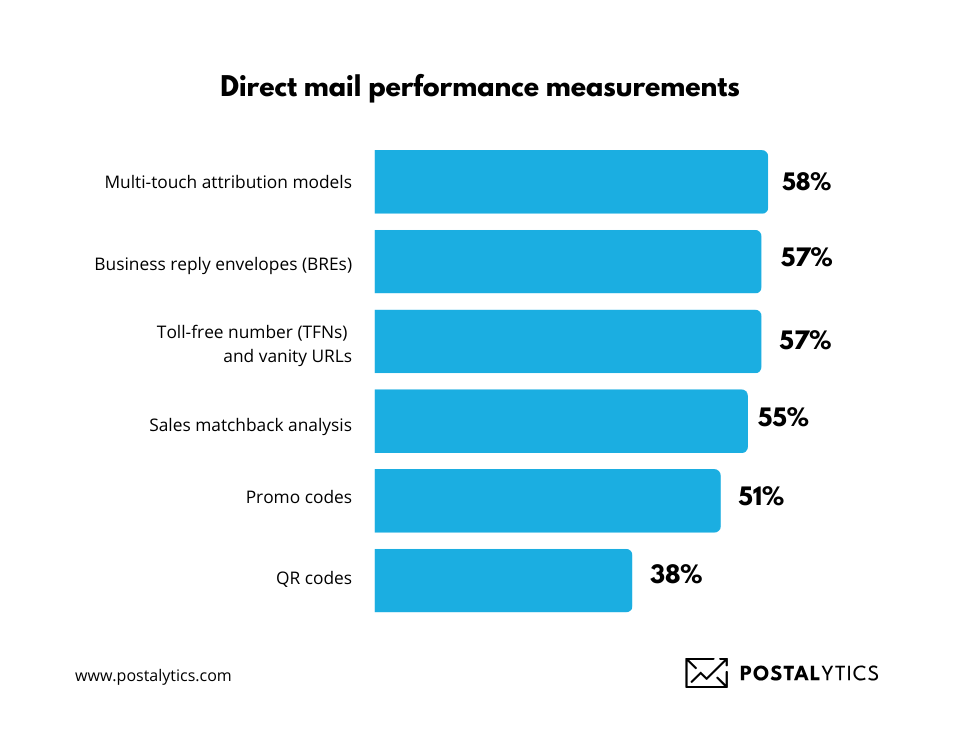
- 25% of American consumers prefer direct mails and catalogs over other advertising channels and formats. (31)
- Half (52%) of customers expect direct mail to be personalized (7)
- Automobile (70%) is the number one industry that uses direct mail, followed by travel and hospitality (53%), financial services (51%), and retail (48%) (8)
- 1/3rd of marketers spend 25% of their marketing budget on direct mail. (9)
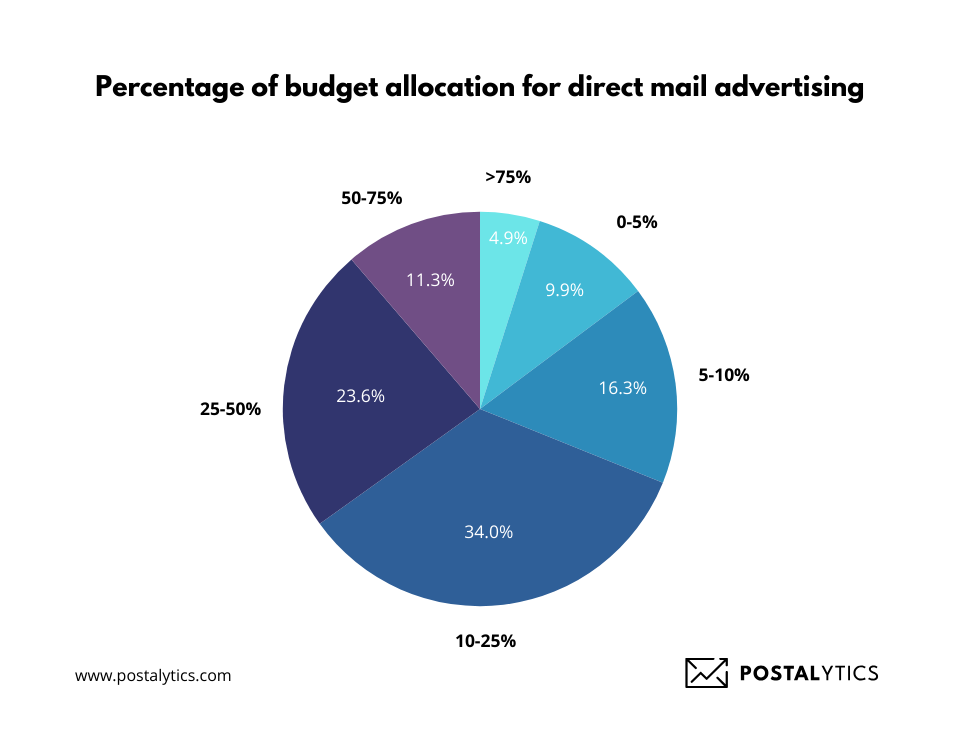
- 59% of marketers expect an increase in the use of direct mail in the next five years. (9)
- 51% of consumers sometimes or often share direct mail with friends and family. The major reason for this is shared discount coupons and promotions. (7)
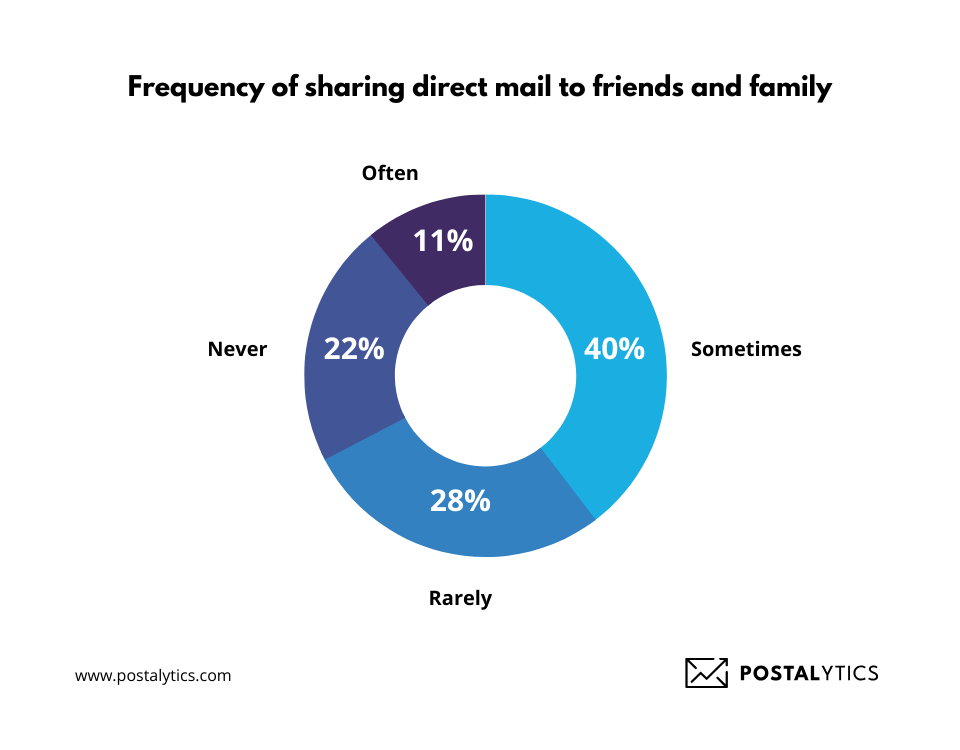
- Most marketers use direct mail to increase purchases (64%), create brand awareness (60%), and generate customer interest. (10)

Direct Mail Statistics on Effectiveness
In this digital age, people are constantly targeted with ads, emails, messages, and other digital campaigns. Customers now crave physical touch and respond to what feels personal, like direct mail. For businesses looking to connect with customers, create brand awareness, or generate good ROIs, direct mail is what you should opt for.
15. Direct mail is kept in the recipient’s home for-.
- 17 days for advertising mail
- 45 days for bills and statements
- 38 days for door and drops (11)
16. These actions were driven by customers receiving direct mail-
- Website visits- 77%
- Purchases-64%
- Program signups-56%
- Store visits-53%
- App download-53% (10)
17. A study shows that using email and catalog together shows a 49% sales lift and a 125% lift in inquiries. In comparison, “email only” recipients only saw a 28% increase in sales and a 77% lift in searches. (12)
18. Mail-drive customers spend 28% more than those who did not receive a mail piece. (13)
19. Top format most likely to read (industry edition)-
- Retail-Catalogs/magazine (53%)
- Healthcare-Letters and envelopes (45%)
- Financial services (48%)
- Local businesses- brochures (46%) (7)
20. Paperless statements are mostly popular among young consumers; however, the majority of consumers (70%) still opt for at least some paper statements. (7)
21. Direct mail outperforms digital channels in terms of response rates, with an impressive 4.4% rate compared to email’s 0.12% 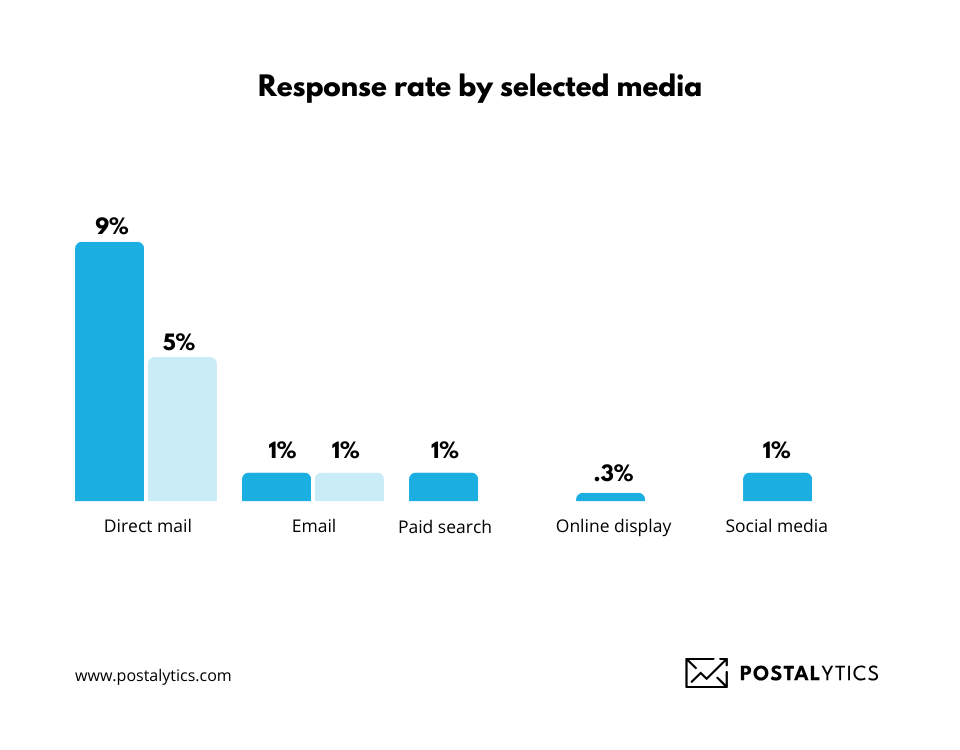
22. Likelihood of opening/ reading a direct mail from a brand if it has-
- Single offer or promotion- 72%
- Multiple offers or promotions- 73%
- First and last name- 51%
- A local event or location- 60%
- Name of an item you recently purchased/ viewed online-58%
- Image of an item you recently purchased/viewed online-59%
- Personalized URL-42%
- QR code-37% (7)
By adding a name to your direct mail, you can increase response rates by 135%. (30)
23. 39% of customers say that they try a business for the first time because of direct mail advertising. (15)
24. US advertisers spent $167 per person to earn $2095 of goods sold. That’s 1300% of ROI. (16)
25. 92% of millennials have made a purchasing decision influenced by direct mail. In fact, an impressive 62% of consumers who responded to direct mail ultimately made a purchase. (16,30)
26.Mail boosts loyal readership-
- Consumers spend an average of 30 minutes reading their emails on any given occasion
- They spend 45 minutes with magazines, 30 minutes with catalogs, and 25 minutes with direct mail. (17)
- Around 42.2% of direct mail recipients either read or scan the mail they receive. (30)
27. A survey by InfoTrends says 84% of consumers feel that personalization makes them more likely to open direct mail. 
28. Direct mail receives the highest ROI of 112% across all mediums, followed by SMS (102%), email (93%), paid search (88%), social media advertising (81%), and digital display advertising (79%). (3) 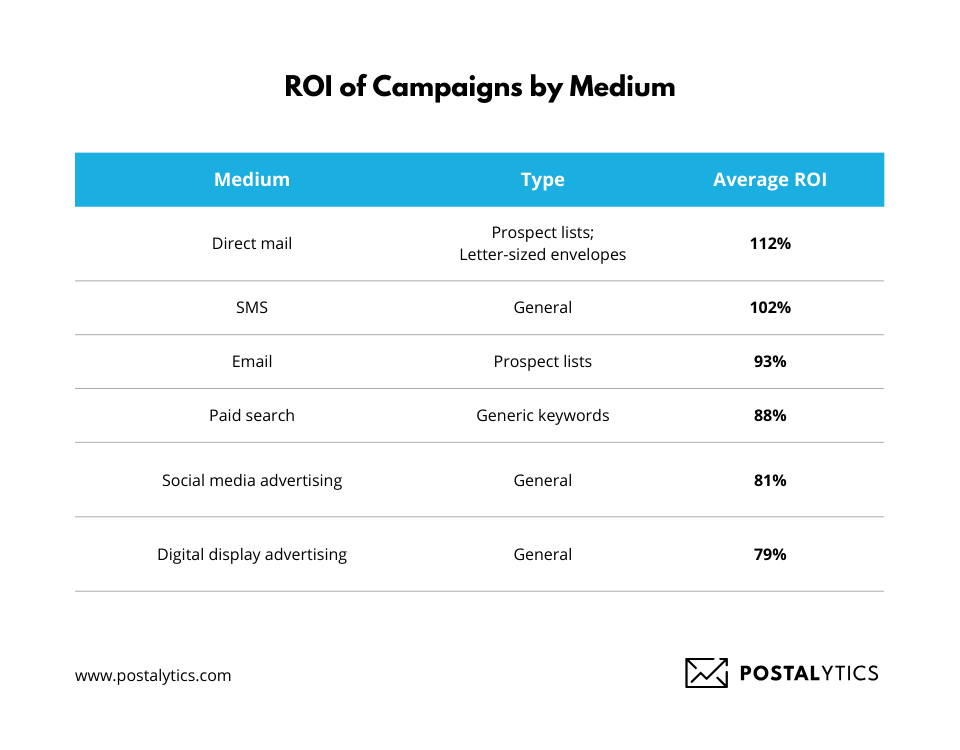
29. Coordinating digital and direct mail increased response rate by 63%, website visits by 68% and leads by 53%. (19)
30. 71% of consumers feel that direct mail is more personal than online digital communication. (20)
31. 62% of consumers say that direct email has inspired them to take action. And 64% say it was because of an offer or promotion. (7) 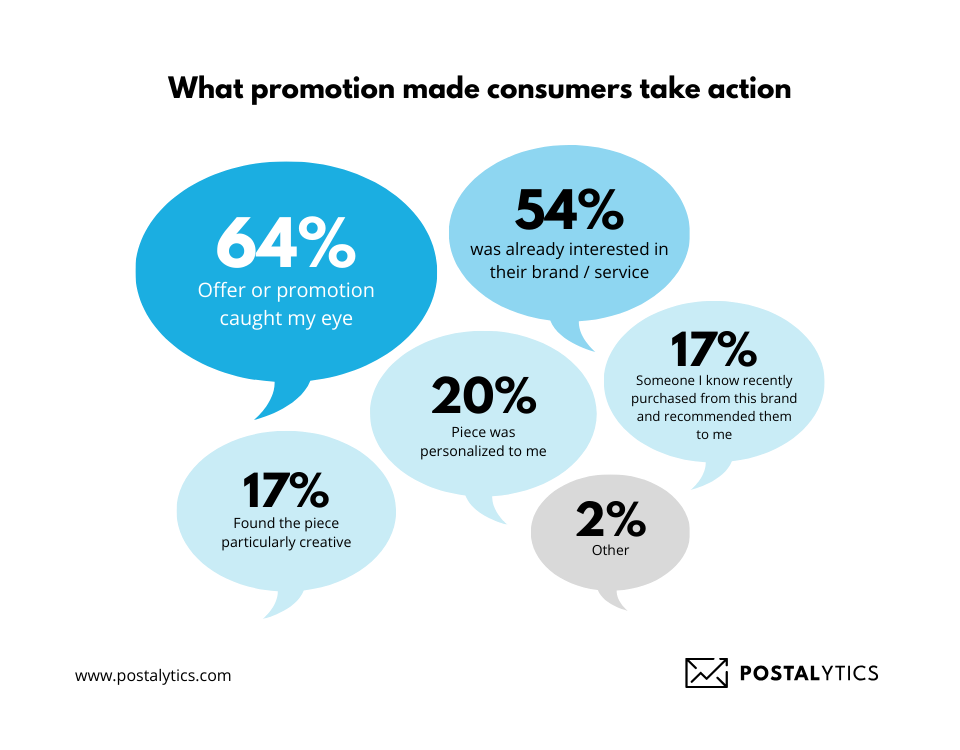
32. Integrating direct mail into our marketing mix increases sales by 27%, acquisition by 40%, and market share by 104% (11) 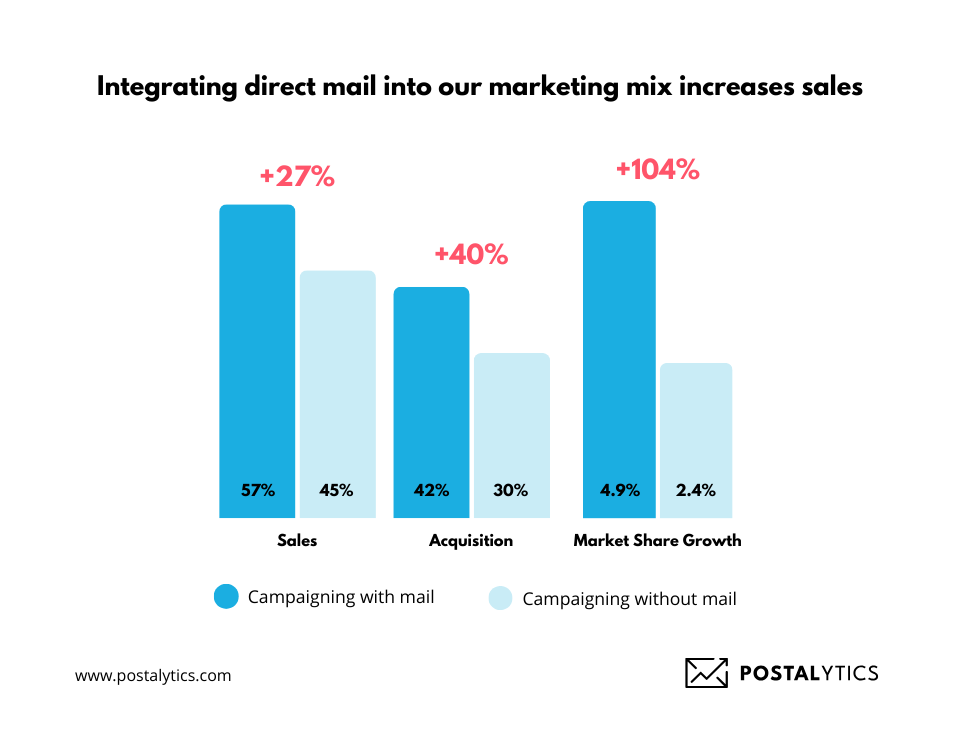
33. 23.4% of consumers will respond to a postcard if the offer is valid, which is 7.9% higher than letter-sized envelopes. (3)
34. Direct mail speeds up the purchase timeframe. On average, any purchase decision takes longer than a week and over a third takes more than a month. However, with direct mail, 73% of purchase decisions take only 1+ day. (21) 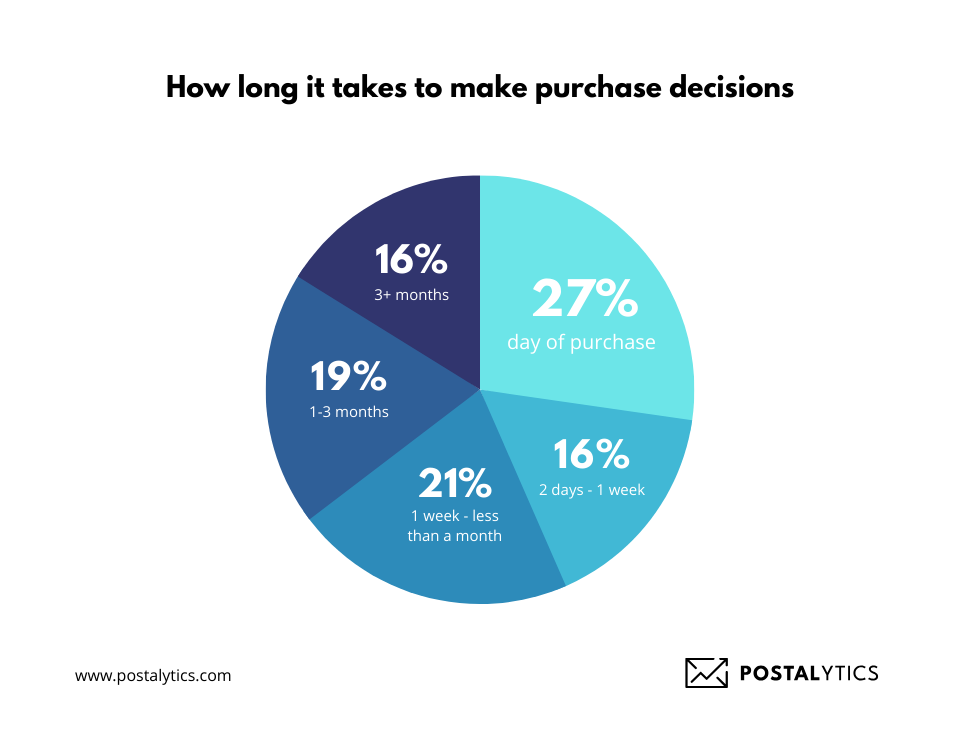
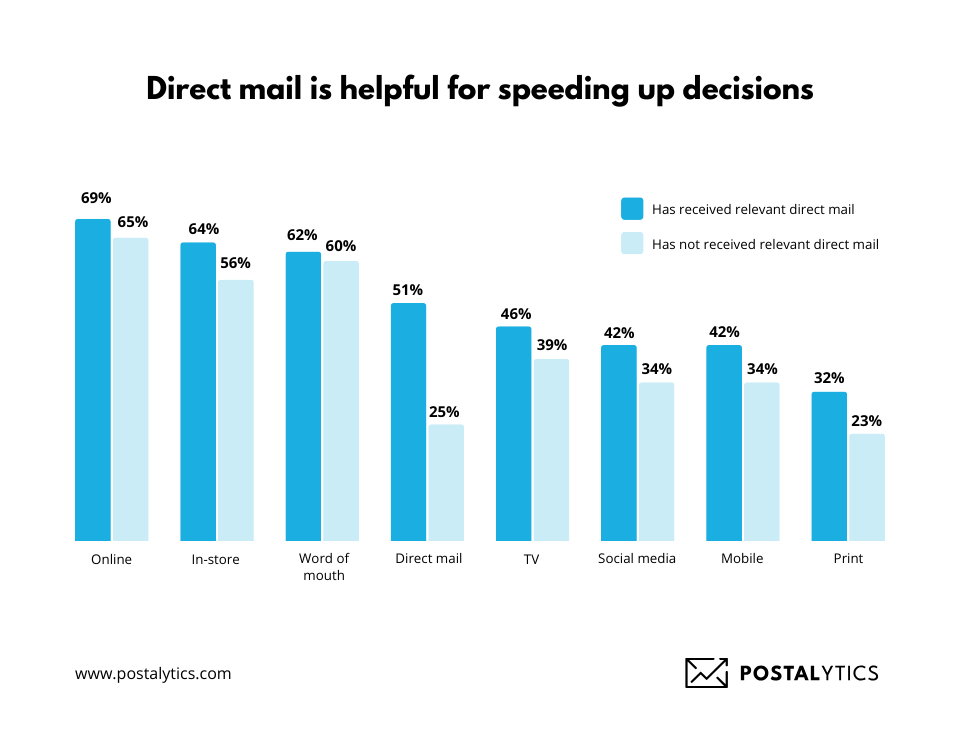
35. Direct mail has also helped me make a choice. 83% of purchasing decisions of customers were influenced by direct mail. (21)
36. Study shows that online campaigns that include both digital ads and print media are 400% more effective. (22)
37. On average marketers spend between $100-500 per person on direct mail (6)
Email vs. Direct Mail Statistics
Email is often considered a substitute for direct mail, but those views would be wrong. Direct mail and email are unique marketing channels, and prospects engage with them differently. Customers also think that direct mail is easier to remember, cheaper, and a better way to communicate than email.
38. Direct mail is easier to understand and recall in comparison to digital media. It takes 21% less cognitive effort to process information and brand recall through direct mail. (23) 
39. 57% of customers abandon email addresses because of too many emails. (24)
40. The average lifespan of direct mail is 17 days, compared to the average lifespan of an email is only 17 seconds. (25)
41. Research shows that 58% of millennials worry less about direct mail privacy than digital media privacy. (26)
42. 50% of consumers aged 35-55 years say that receiving emails from brands feels more important than getting emails. (7)
43. Email is now the new junk mail- 50% of respondents believe that they receive too many emails. (7)
44. Direct mail has a higher open rate of 80-90%, whereas email has 20-30%. (29)
Wrapping up
These direct mail statistics tell a story of a newly found opportunity in an overlooked marketing channel.
If you add automation to the mix, you can quickly create an unstoppable marketing omnichannel.
This is an ideal time for marketers to check out direct mail and start making real-life connections that make people take action.
Reference resources
- Four in 10 Americans Look Forward to Checking Mail (Gallup)
- Number of direct mail pieces received by the average household in the United States in 2020 and 2021, by type (Statista)
- ANA Response Rate Report, 2021 (ANA Driving Growth)
- Direct mail advertising in the United States (Statista)
- Most common direct mail formats used by marketers in the United States as of April 2020 (Statista)
- 2022 Direct Mail Industry Benchmark Study (SeQuel Response)
- The State of Direct Mail Consumer Insights (Lob)
- Direct Mail ROI Surpasses Digital Mediums (LinkedIn)
- Direct Mail Insights from Marketing Leaders (Media Logic)
- How Marketers Like You Use Direct Mail (USPS Delivers)
- Royal Mail-Market Reach Effectiveness of Mail (Royal Mail)
- Why Catalogs Are Making a Comeback (Harvard Business Review)
- A Marketer’s How-To (and Why-To) Guide to Using Direct Mail (USPS Delivers)
- Direct Mail Response Rates Rose Significantly In 2018! (Spectrum)
- 10 Print marketing statistics you should know (DMR)
- The Customer Experience Just Got More Personal (Baseman)
- Mail connects in ways other media can’t match (MailMo)
- Direct Mail: Integral to the Marketing Mix (Infotrends)
- The Future of Direct Mail Is Here, and It’s Dynamic (USPS Delivers)
- 4000 Consumers-4 Generations (USPS Delivers)
- Activating Decisions at Home with Respect and Relevance (Hubspot)
- Top Print Advertising Statistics and Effectiveness (Top Media Advertising)
- Canada Post Neuroscience Research Into the Power of Direct Mail (True Impact)
- Head-to-Head: Direct Mail vs. Email [Infographic] (MarketingProfs)
- How we made MailMen for Royal Mail (The Guardian)
- Millennials and Mail: 5 Myths and the Truth Behind Them (USPS Delivers)
- Ultimate Email Marketing Benchmarks for 2022: By Industry and Day (Campaign Monitor)
- Is your newest secret weapon old-fashioned direct mail? (McGuffin)
- Direct mail statistics (Postgrid)
- Direct Mail Staistics (Nerdwallet)
- Direct mail high on the list of consumer ad receptiveness (Marketing Charts)

